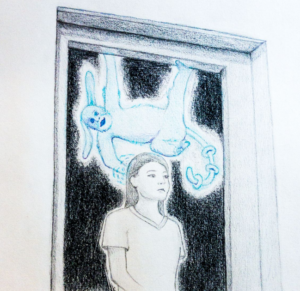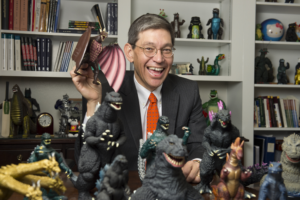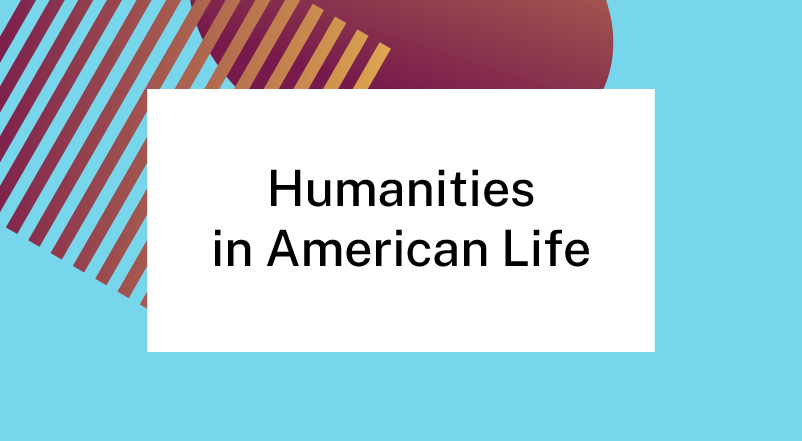Imagining Japanese Monsters with Dr. Bill Tsutsui
by Sydney Boyd, project manager, Humanities in American Life

If you walk into a room only to immediately forget what you went there to do, you might find the kiokusaru, a yōkai or Japanese folkloric monster, hanging from the door frame above you. The kiokusaru takes the form of a smiling, long-limbed monkey with a ghostly blue hue, and it steals short-term memories. Though this may sound alarming, the kiokusaru doesn’t mean you any harm—in fact, the playful monster often returns the memories it steals—and like many traditional yōkai, responds to something in our day-to-day lives that we can’t explain.
It’s also a monster that Harvard University student Christina Yee imagined in a creative assignment for “Japanese Monsters,” a course that Dr. Bill Tsutsui, who serves on the board of the Federation of State Humanities Councils, taught this spring about Japanese mythology, pop culture, and folk belief. The kiokusaru is a classic yōkai—though they often take menacing forms, monsters have been funny forever, Tsutsui told me.
The course explored the ancient history of yōkai as well as more modern iterations—in advertisements, freak shows, sideshows, movies, comic books, and beyond—that have also grown as political and stereotypical machinations of Japanese culture.
“Japanese people historically and today have an imagination of monsters that I believe is unparalleled in the world” Tsutsui said. “Japanese have just been prolific in creating monsters since 1945—particularly maybe since 1954 when Godzilla first came out—and now Japanese monsters are everywhere. Pokémon live among us.”

Beginning with ancient texts like the 8th-century Kojiki, Japan’s foundational mythological text that Tsutsui said is “crawling with monsters” and “a monstrous, scary world from which Japan is born,” the course journeyed through centuries of monsters into the modern era to think about how and why curses, hauntings, and monstrosities are engrained in Japanese culture. This includes monsters like Pokémon, but more compellingly from Tsutsui’s perspective, seemingly innocuous creatures like Hello Kitty—“Hello Kitty creeps me out,” Tsutsui told me. “A cat with a giant head is weird!”
“This monstrous imagination, what can that tell us about Japan? The stresses of Japanese life, the anxieties of the Japanese people, because monsters are often associated with tensions in society,” Tsutsui said. “So does this suggest that Japanese people are actually much more tortured than they look to the outside world? I think that’s probably true.”
From advertisements to literature and film, the public curiously went wild for monsters during a period of one of the wealthiest and most peaceful times in Japanese history, Tsutsui said. “And yet there are monsters everywhere, and you gotta ask yourself: what are they haunted by?”
Monsters are ubiquitous now, but they were noticeably everywhere right after World War Two as Japanese pop culture began to become globalized and, by extension, politicized—namely, when the breakthrough Godzilla movies reached international shores, Tsutsui explains.
“It drove the Japanese government crazy, actually. They wanted to promote what we now call ‘soft power’ during the 1950s, they realized Japan had to be rehabilitated in the world’s eyes after World War Two,” Tsutsui said.
Tsutsui said that the 1964 Tokyo Olympics were the apex of this effort, but the Japanese government also sought ways to use cinema and literature as a means of restoring its reputation.
“The problem was [that] they codified a very stereotypical view of Japan in the process, and to me, one of my favorite aspects of this is they really structured American views of the Japanese people as being physically small and passive,” Tsutsui said. “Japan is this place attacked by giant monsters, and what do Japanese people do? They scream and run. It really played to a lot of American feelings of superiority after the war, after Japan’s defeat, as well as racial stereotypes of the Japanese.”
Japanese monsters like Godzilla draw upon centuries of history filled with long-standing anxieties and trauma—something that contemporary yōkai narratives often hide in plain sight. The most recent Godzilla vs. Kong is no exception.
“It ends up, ‘Oh, the world is saved, we’re all so happy’ –wait, Hong Kong has been destroyed and thousands of people have died, and that is completely unmentioned,” Tsutsui pointed out. “In our class we found lots of examples of this—really disturbing things in Japanese monster culture and its globalization—that in some ways you might say ruin the products for us, and yet of course, make them so very interesting and reveal the power they have in our society today.”

This post is part of “Humanities in American Life,” an initiative to increase awareness of the importance and use of the humanities in everyday American life.
Photo Credit: Christina Yee and Bill Tsutsui


